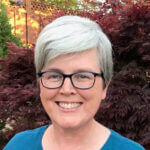At the end of 2020, Karen Cowe, Ten Strands’ CEO, and Linda Livers, Ten Strands’ consultant, interviewed three staff members of the Park Day School in Oakland, California: Angela Taylor, head of school; Jennifer Cooper, facilities manager; and Josie Shapiro, director of admissions. This interview was originally published as a case study on the National COVID-19 Outdoor Learning Initiative website. You can read all of the inspiring school, district, and county case studies here.
Park Day School, Oakland, California
Park Day School is an independent school in Oakland, California. The school’s campus is an urban oasis that includes 4 acres of green space with over 150 trees. The school serves 275 students, in grades K–8, and includes 58 staff members.
In November 2020, the school started to bring students back to campus for in-person instruction, using a phased plan by grade level. Once all of the grades had returned to on campus, 92% of all students were attending in-person instruction in outdoor classrooms, 50–100% of the time. Teachers are also working with a small number of students remotely during the pandemic.
The new outdoor learning spaces are much-loved by the school community and have allowed them to operate a safe, full-time, in-person and distance learning-friendly program for all students.
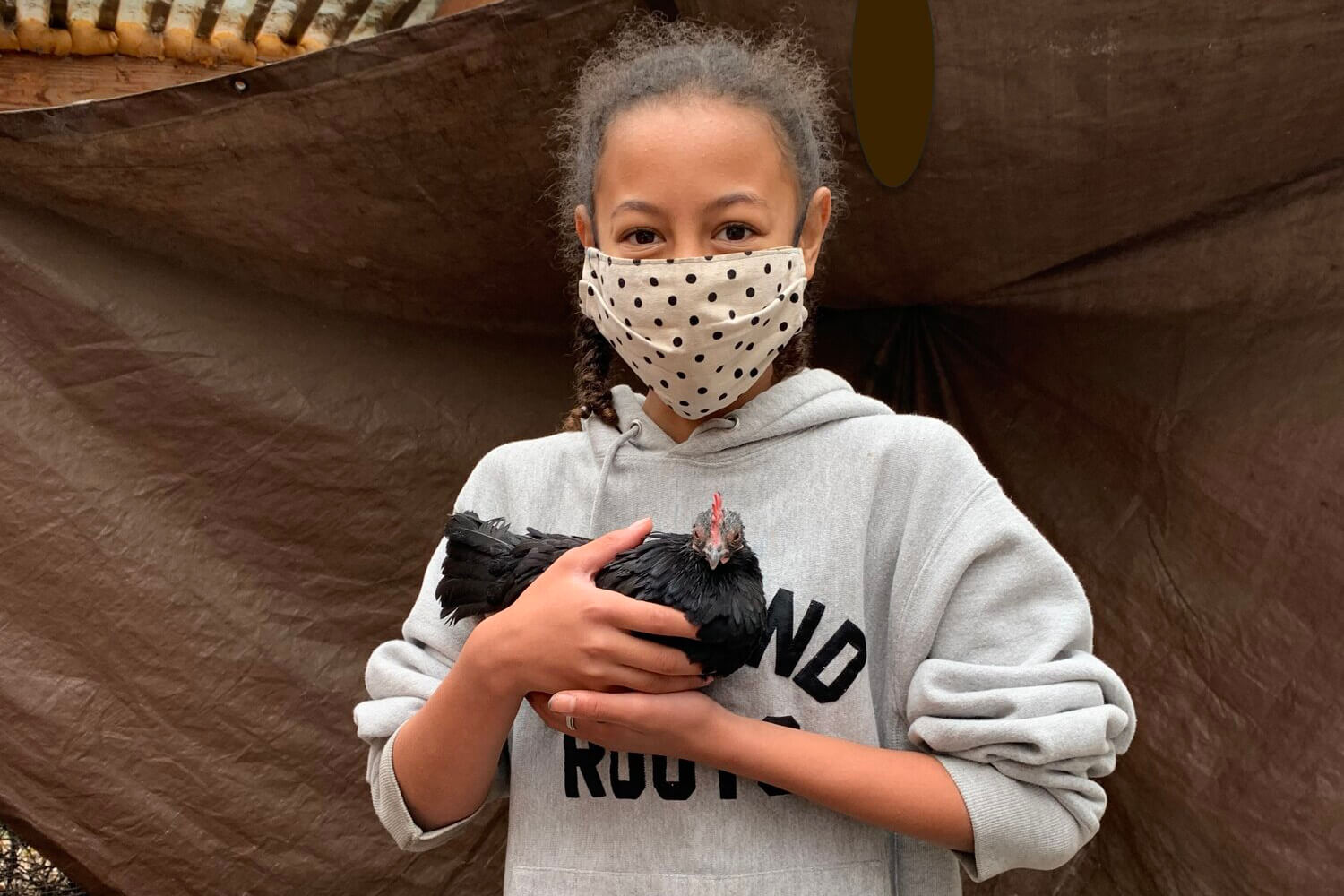
Interview
Q: How did your school use outdoor spaces before the pandemic?
JS: Well, very thoroughly, but it turns out not as thoroughly as it had the potential to be!
JC: While we’re an urban school, we really are an oasis on 4 acres in the middle of the city. Unlike many schoolyards, we have a very natural landscape with over 150 trees of different varieties, including fruit trees. We utilize two different garden areas on campus where we’ve held learning garden classes and where students make things with natural materials in the Create With Nature zone. Beyond that we have a learning garden program, an Innovation Workshop that is an indoor-outdoor learning space, and teachers who often take grade levels outside to connect different science lessons to real outdoor experiences. We also have chickens in our chicken coop, which is a favorite for many students from our youngest up to our middle schoolers. We have definitely been utilizing our schoolyard beyond recess. We’ve always eaten lunch outside whenever weather permits, so our students were used to that.
JS: Our indoor-outdoor Innovation Workshop space helps engage students directly with the learning, which invites them to take real ownership over the campus and their learning environment. Projects that come out of the innovation workshop result in taking a design-thinking approach to our campus and figuring out what’s missing and what can be built. Some past projects include an outdoor kitchen and three years ago the middle school Innovation Workshop elective built a really cool multi-layered wooden bench seating area that middle schoolers designed because they thought there wasn’t enough hangout space. Using the campus as a canvas is really helpful for engineer thinking and design process work that supports our social-emotional learning program.
There’s so much time spent on this really exciting campus, so as you can imagine, sometimes there are social bumps with the kids as they’re navigating the spaces. Two years ago, the third graders were having a particularly hard time around the swings so the teacher suggested they make a Plinko machine, which they designed in the innovation workshop. Students can drop a little ball in the top when they’re having a problem and it can go into a “use I statements” or “hug it out” slot for suggested solutions. The Plinko machine sits right in the yard for any student facing a bump and needs a little help solving it. So, there’s a lot of really interesting ways we’ve been able to encourage our kids to take ownership of their campus.
Q: How did your school decide to bring education outside this year?
AT: It was really an integral part of our whole health and safety protocols for COVID. I think we knew right away intuitively that we’re sitting on a natural resource that many schools don’t have access to. Our infectious disease specialist reiterated over and over how much safer it is to be outside, so it started quite simply, Oh, we’re going to create some outdoor spaces, we have tree stumps, we have all of these things! And, then it evolved into 23 outdoor spaces that align with our smaller size cohorts of 12–14. We are committed to having an indoor and outdoor classroom for each and every cohort and have shared with our community that we are going to stick with 50% instructional time outside post-COVID. The hum, the laughter, and just the excitement and energy that’s on campus with the majority of the students learning outside—I will miss this if we go back to 100% inside instruction. Today, our third-grade students took a field trip to their actual indoor classroom and it was the first time they had ever seen it, as they’ve been 100% outside this entire time.
JS: Strange gifts are bred of necessity. There have actually been so many upsides to this vision that we first created with safety as the impetus.
JC: Our kindergartners go on stormwater scavenger hunts to identify where stormwater goes here on campus after coming down on the roof. Students are going to make murals on some of the campus storm drains. We have a rainwater harvesting system and two large cisterns that feed one of our gardens, which are used alongside the fifth-grade science curriculum.
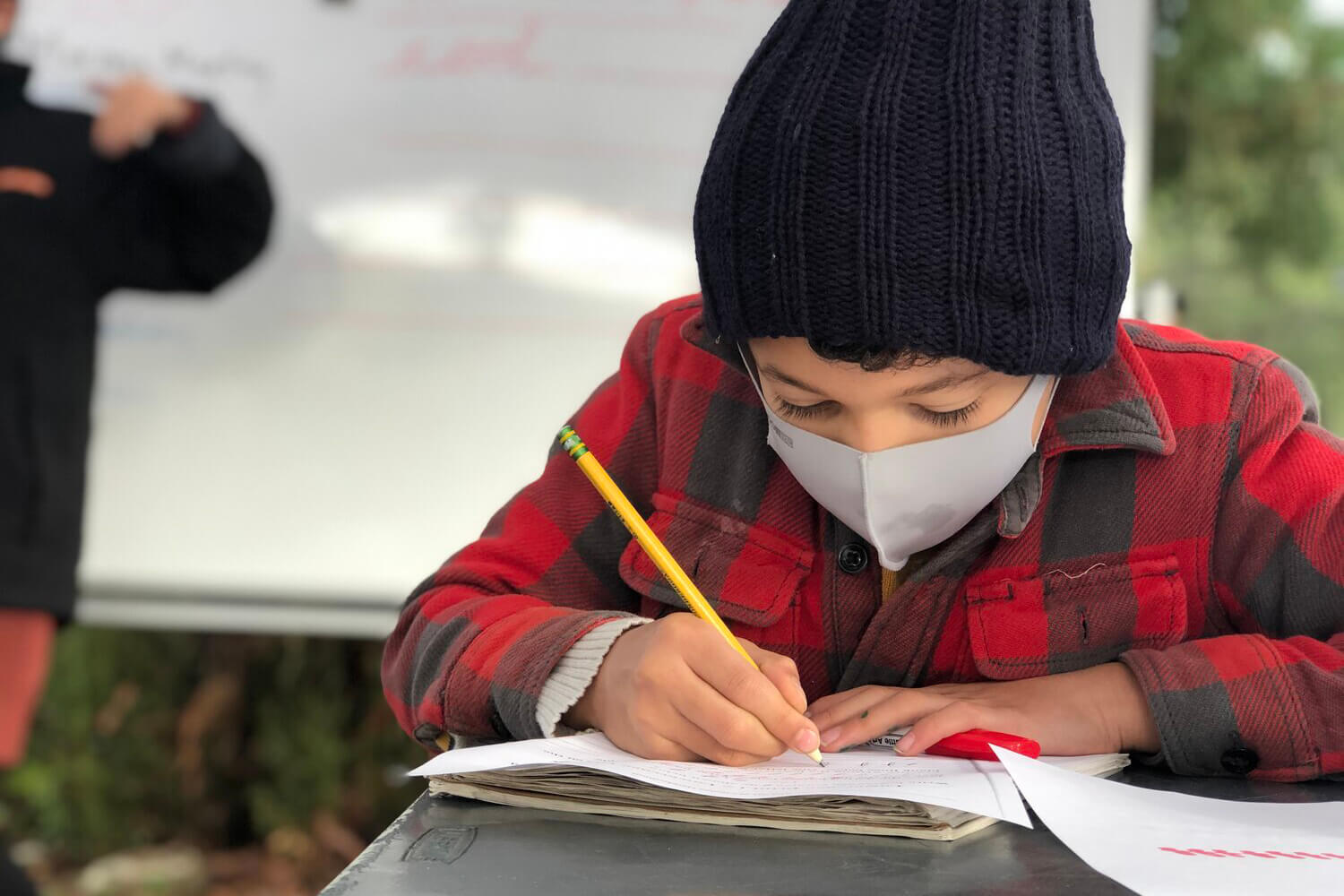
Q: How did you prepare your staff and school community to take learning outside this year?
AT: This started with heads of East Bay independent schools and we shared interest in tapping into our outdoor space and were in the design process. Yalda Modabber, the head of school at Golestan, who has an infectious disease background from Harvard Medical School, generously offered an educator’s point of view on safely working outside to our faculty and allowed a core group of our teachers to take a field trip to their campus. We got a chance to see up close and personal what was possible and what we could do with a larger footprint. That’s when the idea of some tree stumps in a circle bloomed to 23 outdoor spaces!
JC: We learned that one size does not fit all! I met with grade-school teachers around their wants and needs, what they were looking for in an outdoor learning space, how often they were going to be there, what kind of furniture they’d need to accommodate their students’ learning, and we started to allocate different spaces. We have stump circles for our kindergartners and first graders where the teachers wanted to be, in natural settings under the trees. Other classes were looking for a setting where students could do everything they needed to do outdoors—needing seats and desks, followed by tents. We brought back two grades at a time for a gradual growing of our outdoor classroom areas.
We have a very small, really good facilities staff that was very active in setting up our outdoor spaces. We have a maintenance person, groundskeeper, and a day porter whom we brought along for the ride! They became tent-erection specialists along with additional key folks who assisted in the large tent setup. Now the custodial staff are doing more, including sanitizing indoor and outdoor spaces.
AT: I think parents and guardians love it! It was going to rain one day, and several parents emailed us that they wouldn’t send their kids to school if class was shifting indoors. They were bought into the safety of being outside during this time. The mother of a middle schooler with a severe autoimmune disorder feels incredibly safe with her daughter here, outside.
JS: We have many true partnerships with community organizations—each grade partners with an organization throughout the year and is cultivated by the class and teachers. For example, third grade has a big bird research project and partners with the Audubon Society. Speakers come in and we go to Audubon’s preserve areas. Kindergartners have a unit on how acorns and trees grow and the properties of wood, so we partner with EBMUD (East Bay Municipal Utility District) and are a part of their reforestation and creek restoration efforts. Field trips, although currently on hold with COVID, and various speakers all cycle around these big academic units. First grade partners with Oakland International High School, just around the corner from us; 100% of OIHS students are English language learners, nearly all of whom immigrated to the US during the last four years. This is a beautiful partnership because we’re teaching first graders the process of writing English as their native language and the older kids might be learning to write with English as their second language.
Earlier today, our students wrapped a project with Lava Mae, another partnership, to build mobile handwashing stations in the Innovation Workshop. Lava Mae works to bring mobile showers and other services that promote well-being to people experiencing homelessness. Hosting guest speakers from these organizations has been something we’re able to do over Zoom even in the pandemic. We look forward to the day when our field trip program can open up again.
AT: We have not sought any particular outdoor education expertise aside from Golestan and the Green Schoolyard National COVID-19 Outdoor Learning Initiative templates.
JC: I went to quite a few of the different Green Schoolyard workshops for outdoor educators when I was the gardening teacher. Joe Patton, the new gardening teacher, has also done some of the Occidental Arts & Ecology Center and Green Schoolyards workshops. We’ve also used some of Lifelab’s curriculum in our learning gardening program.
“Outdoor Classrooms Are Open!” video from Park Day School
Q: How did your school plan and implement your outdoor classroom infrastructure? What was involved? Who did you find to help you with this? Were permits needed?
JC: I did a lot of it, with help internally. We received a quote for tent rentals of $25,000 a month and knew that wasn’t going to work for many months. We looked into purchasing tents and did. Because they’re considered temporary structures, we do not need permits as of right now.
We’ve reconfigured a lot of furniture that we already had here on campus, from picnic tables, to old chairs that we had up in our attic, to a lot of plastic folding tables and stools. We did purchase some smaller folding tables for outside. We’ve moved things around from the typical areas like where we would have had picnic tables for lunchtime eating; they’re now in an outdoor classroom. We have lots of different types of tents, different sizes, depending on the different situations. I think it was really helpful to show teachers the Green Schoolyard templates to envision their class—for example, a tent for a 28-foot diameter circle. So, I started templating our site plan and ended up with 23 sites and counting. We’re about to add a few more. (See video above.)
In addition to the heads of independent schools in the East Bay group that meets, we have facilities groups that meet, too—one throughout California and another here in the East Bay. It is very helpful, as we talk about everything from marking dots with spray chalk to properly setting hand sanitation stations.
Q: What types of planning and implementation did you do related specifically to COVID health needs? Did you see expert advice?
AT: We sought expert advice and worked with two firms, Capsid Consulting and Joffe Emergency Services, to make sure that all of our protocols were above and beyond what the county was asking for. We really have a layered approach with different mitigation factors from masking, to social distancing, to cohort sizes, to contact tracing, to testing. We put all of that in place and then some. We wanted to assure our staff and our students’ families that if they were coming to work or school, they were as safe as possible.
JC: We have about 10 outdoor handwashing stations. We do not have one for each of the 23 outdoor learning spaces, but we chose critical locations for installing the outdoor sinks above and beyond what we’ve had in the past. Many of the sinks have either foot pedals or touchless sensors. We also have another more portable kind of handwashing station that we’ve added adjacent to other outdoor classroom areas, in addition to lots and lots of hand sanitizer.
AT: I just heard today from some of the sixth graders that we might get another one of the Lava Mae handwashing stations somewhere.
JC: Yes, we’re trying to build another one of those for sixth graders. They’ll work on it and maybe even design some improvements to it as they use it. We’re going to try to do this project again next year with sixth grade, so this class might share what they’ve learned.
AT: Some younger children speak and play with such enthusiasm that they go through masks quickly. So a colleague, Yalda Modabber from Golestan School, recommended students having extra masks and we followed suit. This actually does help, as I see on recess duty with kindergarten or with kids after lunch—they are switching out masks. As part of the school supplies, we asked families to send three clean masks to school with their children daily.
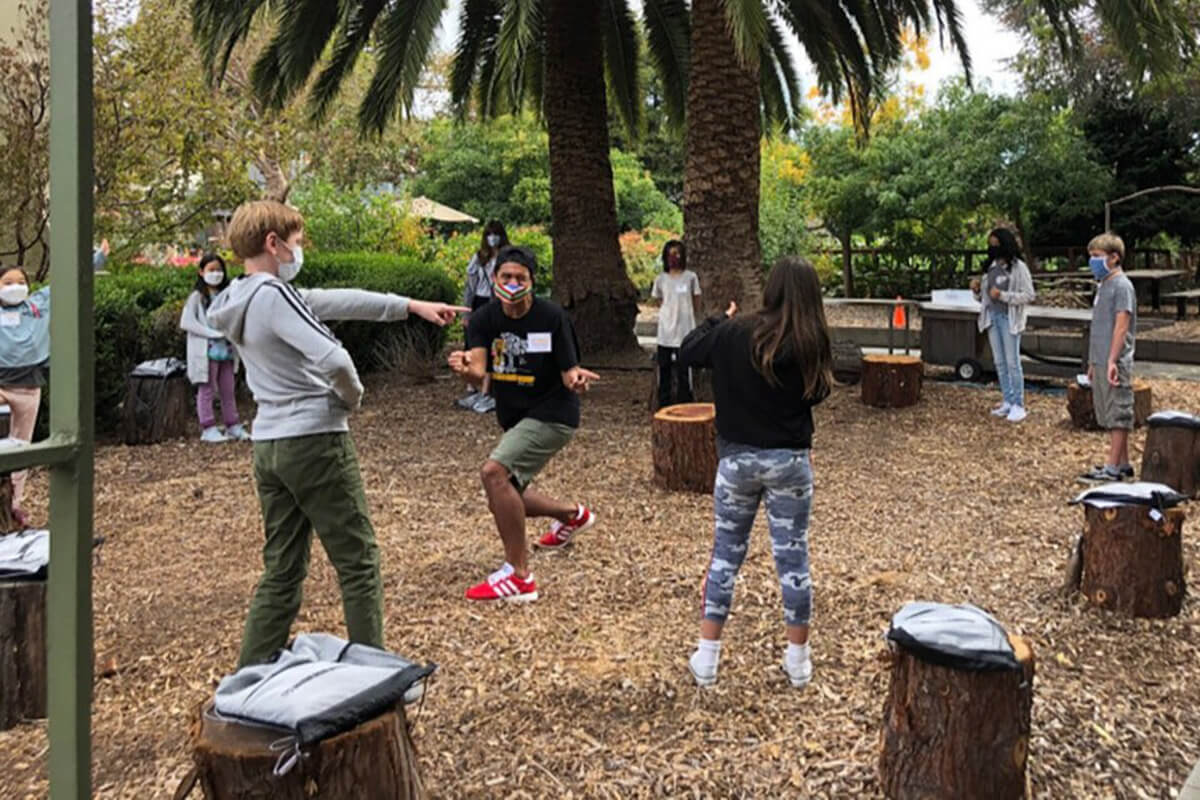
Q: When did your school reopen (outside)? How is it going for you now? Tell us a little about the logistics involved with being outside.
AT: We started to reopen on November 2, 2020, with our first group of kindergarten and first graders; then on the week of November 16, we brought in second and third graders; on the week of November 23, we brought in the fourth and fifth graders for a few days, followed by the week off for Thanksgiving break. Then we brought back sixth graders and so on, so today was the first day that all K–8 students were on campus, about 255 students out of the 277 total students. There’s a small chunk in most grade levels who are still learning from home, although we anticipate those numbers will drop in a post-vaccine world. To accommodate our at-home learners, we’re running hybrid classrooms—teachers are teaching children in front of them and also engaging those learners still at home. So, there is a tech infrastructure that is an integral part of this process and we had to ensure those electronics were going to be okay. An outdoor setting was really the impetus for that. We said from the moment we started, we’re committing to our students’ families whether they come to school or stay home, we still owe a robust academic experience. So, our teachers are juggling a lot.
It’s wonderful that families and staff trust us. But, I think the latest shelter-in-place order (December 2020) was frightening in that the behavior of others could potentially impact us. The bubble that we’ve tried to create, is it enough? We had teachers asking themselves, Are we safe? Is this going to be okay for me? Only two teachers from our staff made the decision, once the shelter-in-place order came into effect, to not come to campus until we are out of this shelter in place. Their health profiles are such that they probably could have said that earlier on, but they felt safe. But, with the shelter-in-place order, they were in a place to reconsider. We’ve hired subs for this short period of time, just these two weeks, and everybody is back in once the surge is behind us.
Q: Have you heard any feedback from the teachers and students about being outside?
AT: “It’s cold!” These little California cuties are just not used to being outside in the cold. I think that was the first few weeks and they’ve evolved. I get the pleasure of standing at the front gate every morning for about an hour. I am taking temperatures, looking at their morning health questionnaire, and getting everyone sanitized, so I get a chance to chat with students and families daily as they’re dropping their kids off. I have little ones saying things like, “Angela, I have on long underwear!” So, kids have evolved with the weather needs.
We purchased jackets for all of our teachers. (Josie modeled the warm jacket via Zoom!) For teachers, I think it really varies. They’ve definitely warmed up to their outdoor classrooms; I think they feel safer outside and in many cases are choosing to be out there. We’re trying to help them with rolling bins, rolling whiteboards, and other things that can bring the tools to them. But it takes some getting used to.
Some of our kindergarten and first-grade teachers, who still have the more natural setting classrooms, have been rethinking activities like really practicing pencil grip for handwriting. The tree stumps and lap desks might not be the ideal setup, so they’re transitioning inside for a desk area that works better for that activity. So, teachers are kind of thinking about the activity and choosing the space that best fits. This was how we were hoping they were going to start, but it took some adjusting.
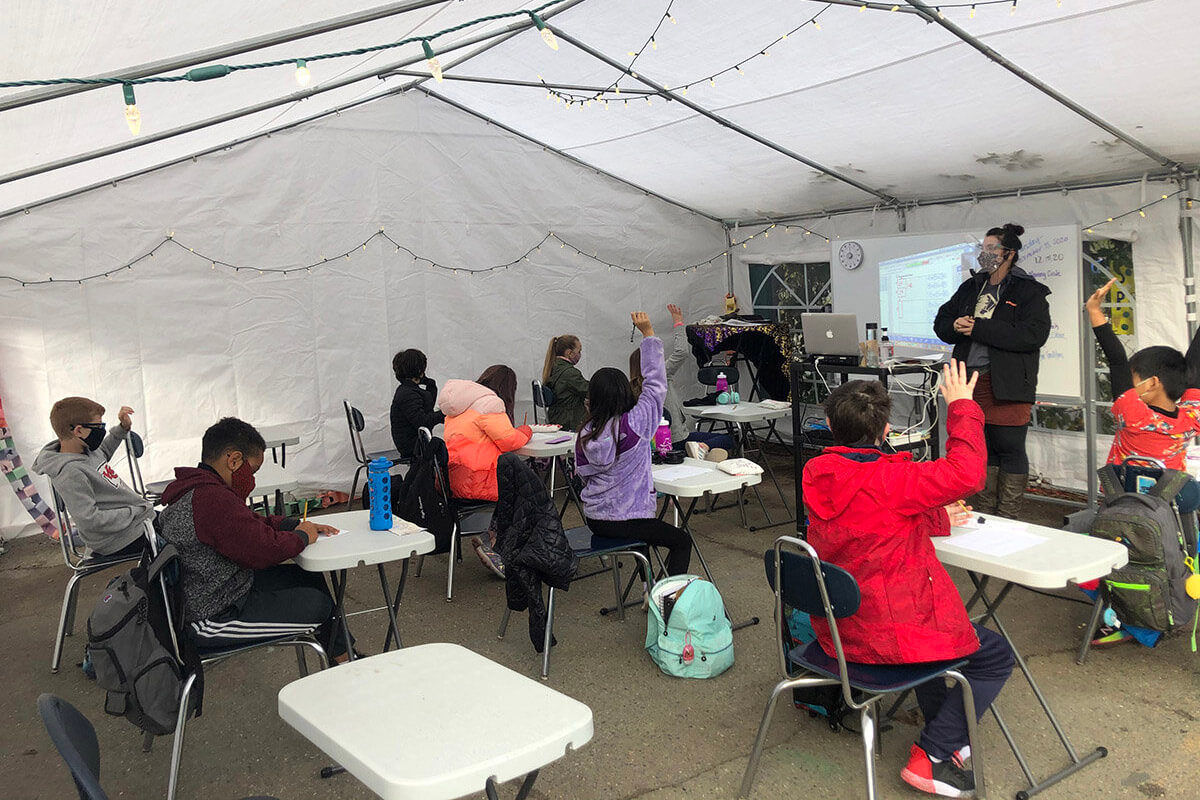
Challenges and Successes
Q: What would you say have been the biggest successes, and the biggest challenges of holding school outdoors?
JS: Being able to bring kids back on campus in person in a way that feels safe and reduces some anxiety, that’s the biggest success!
JC: Yes, being able to have more than 90% of our students here on campus is an amazing accomplishment given COVID.
AT: The feedback from families has been just so positive. We’ve heard, Thank you for giving my child a level of normalcy that she hasn’t had since March! As for the biggest challenge, I’d say Jennifer’s job.
JC: Many of the big lifts are mostly behind us! As an architect, I love making spaces and used to make outdoor spaces before; now they’re just a little different. I designed the chicken coop and I designed and helped build and oversee the Innovation Workshop. Now it’s just on a much larger scale, as far as numbers. I think a challenge is helping teachers to adapt to teaching outside. Some really adapt well and some are still figuring out the best ways to utilize their outdoor spaces. We definitely have examples of wonderful ways that classes used the materials and documented the creatures that are living in and around their outdoor classrooms. Observations and findings on the green walls of their classrooms are being interwoven into science lessons.
JS: In the curriculum, I think outdoor classrooms have been a real success. It’s the logistics, like sound, that have been challenging. You have to project your voice so much more for the kids to hear you and for the kids to hear each other.
AT: And, rain—rain is challenging. It’s supposed to rain tomorrow and we’re wondering, What’s going to happen? What should we do? I agree with Josie on the sound challenge, because we have these little voices with a mask on outside. That’s a hard one—another layer of complexity that COVID has brought! Sound is especially challenging for lower-grade teachers who are teaching reading and sounds; children need to see how their mouth is making the sound. So, they’re doing some of that inside, where they can keep kids hearing and engaged.
JS: The classroom environment change to outdoors has shifted instruction in younger grades; for example, our Bridges math program has a lot of manipulatives that we use, and now they’re surrounded by and using resources that aren’t all plastic and in bins. This wasn’t part of COVID, but our seventh graders were graphing a parabola outside in the courtyard with a tape line, which was a great way to get older kids outside to move their bodies and open the doors to creativity.
AT: I’ve seen third graders doing measurement outside using natural materials like sticks and leaves of irregular sizes that lead to discussion of regular benchmark measurements.
JC: Originally, one of the third-grade classes had stumps and they were deciding how they might change and redesign the different components within the tent and were doing all sorts of math for designing their space.
JC: Our art teacher has been phenomenal and creating insanely innovative outdoor art projects. They made art installations using leaves and flowers, they were absolutely gorgeous. In the arts as well, it’s really been inspiring to open different creative doors.
Q: What’s next? Do you think you will continue to use outdoor learning as part of your overall approach after COVID is over?
AT: I think there’s going to be a natural drift back inside to some extent, but I don’t think the outside is ever going to go away. We have to use these tents, we spent money on these! I think teachers have gotten a glimpse of how the outdoors can be an asset. Right now, I think we’re at 50% outdoors and 50% indoors, and some closer to 75–100% outdoors, I could see us drifting to 25–50% outdoors post-COVID. When I think about my visit to campus when I was interviewing for this job in the fall of 2019, there was so much laughter and so many children enjoying this campus and I don’t see that going away.
JC: I had this idea a few years ago about different classes stewarding and observing different areas of campus. We’ve had classes map the irrigation system and turn on different sections, then mapping it. Now that each class has been assigned different areas, I can really see something like this happening, and it might morph a little bit. As we go into the spring, things start to grow again promoting that kind of natural observation of what’s going on in their area. And then, how can they take care of it and steward that area? What’s a project that they could do in that area that could help make it a better place? I think we could continue that on and into the future.
JS: We should emphasize, our school was more outside pre-COVID than other schools — there’s a real fluidity and teachers can choose to have their book discussions outside in one of the stumped classrooms. We’re not all indoors except for physical education and learning garden, we’ve always been an indoor-outdoor place. A lot of our classrooms have doors directly to the outside. I think we’re talking about the outdoors in the way we talked about technology, that it is a part of learning, like when we use technology that enhances what we’re studying. The same thing can be said for outdoors.
Q: Would you recommend that other schools try this?
AT: Yes! It has been so transformative in how this allowed us to open safely. In those East Bay heads of schools calls I am hearing from other heads of school who don’t have this lovely natural resource of an outdoor campus. They are struggling, their teachers don’t feel as safe, families don’t feel as safe, and 100% of their students inside 100% of the time is not working.
National COVID-19 Outdoor Learning Initiative
The National COVID-19 Outdoor Learning Initiative supports schools and districts around the country in their efforts to reopen safely and equitably using outdoor spaces as strategic, cost-effective tools to increase physical distancing capacity onsite and provide access to abundant fresh air. The Initiative seeks to equitably improve learning, mental and physical health, and happiness for children and adults using an affordable, time-tested outdoor approach to keeping schools open during a pandemic.

